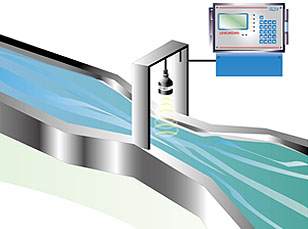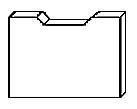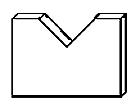Most techniques used to meter flow in pipes are not applicable to flow in open channels. Special devices such as the Parshall flume are required. Parshall flumes are one of the most widely used flumes for permanent flow monitoring. They are especially common in regulating sewage treatment plant influent and effluent, industrial process discharge, and irrigation runoff.
General Information
The gIn open channels, liquid flows with a free surface. Common examples of open channels are tunnels, nonpressurized sewers, partially filled pipes, canals, streams, and rivers.


(Copyright FLOTECH, Inc., Tagore Industrial Ave., Singapore)
Flow measurement through open channels is based upon the head, or depth, of the fluid. As liquid flows across weirs or flumes (the two main types of open channel measurement devices) the head changes. The difference in head across the device indicates the flow rate.
Equipment Design
The depth-related methods of measuring open channel flow operate on the principle that instantaneous flow rate can be determined from measurements of the head of a flowing stream.
The head is a function of the flow velocity based on the type and shape of the primary measuring device. Level detectors, usually sonic devices that bounce sound waves off the fluid surface, are used as secondary measurement devices. They determine the head in an open channel, and thus the area and velocity of the stream.
Trapezoidal flumes were developed by the U.S. Soil Conservation Service for irrigation channels but have been recently adapted for sanitary and industrial sewer applications. The Palmer-Bowlus Flume was developed specifically as an effective wastewater flow-measuring device. Both of these flumes restrict the channel size before and after the constriction.
When the flowing liquid has a high solids content or minimum head loss is necessary, flumes are used. Flumes must be located where there is little or no disruption of smooth flow.
The Parshall flume consists of a converging upstream section, a throat, and a diverging downstream section. The walls are vertical and the floor of the throat is inclined downward. The difference in head between the entrance (Ha) and the exit (Hb) of the flume is used to determine the flow rate. Parshall flumes are designed to handle moderate flowrates, which makes the device self-cleaning.
A weir is a partial obstruction of an open channel that causes liquid back up, forming a higher head behind the barrier. It consists of a notched vertical plate with a sharp crest. Weirs are classified by the notch shape. Rectangular, Cippolletti (or trapezoidal), and triangular (or V-notch) weirs are the simplest of all head-producing primary flow measuring devices for open channels. The schematics below show these three types of weirs.



Rectangular weirs, the first type of weirs used, have a rectangular notch. Simple design and ease of construction make them the most popular type of weir in use today. Rectangular weirs can be configured to handle flow ranges from 0-250 GPM to 0-10,000 GPM.
The Cippolletti weir has a trapezoidal notch in its crest. The slope of the sides is intended to correct the side contractions of the nappe (the over-falling liquid) usually seen in rectangular weirs. The angle of the slope is determined by the height and width of the weir. Cippolletti weirs are designed to handle the same flow ranges as rectangular weirs.
Triangular, or V-notch, weirs have a triangular notch. They are not usually used for flow ranges greater than 0-2000 GPM. Triangular weirs are typically constructed with an angle of 60 or 90 degrees and may be used for flow ranges as low as 0-150 GPM.
Usage Examples
Open channel measuring devices are seen every day in sewage pipes and particularly in manholes, canals, streams, and rivers. Flumes, with their inherently self-cleaning design, meter flows that contain sand, grit, and other heavy solids.
Advantages
- Easy to construct
- Simple to determine flow with proper equations
- Parshall flumes produce one-fourth the head loss of a weir designed to handle the same flow range
- Parshall flumes are accurate in a wide range of conditions
Disadvantages
- Devices must be installed in the stream in a location where there is no disruption of steady flow by upstream or downstream blockages
- Require consistent flow profiles
- Specific constraints on pipe/channel sizes and grades
Acknowledgements
- FLOTECH, Inc., Tagore Industrial Ave., Singapore
References
- Omega Complete Flow and Level Measurement Handbook and Encyclopedia, Vol. 29. USA: Omega Engineering Inc., 1995: Z-15.
- Perry, Robert H., and Don W. Green. Perry’s Chemical Engineers’ Handbook. 7th ed. New York: McGraw-Hill, 1997: 10-19 – 10-20.
Developers
- Erica Mauter
- Matthew Robertson
- Henry Chen
